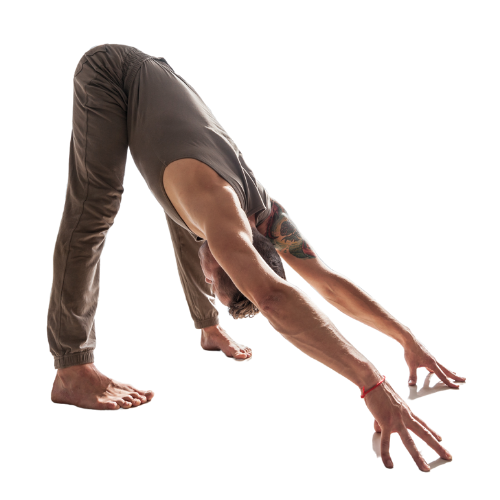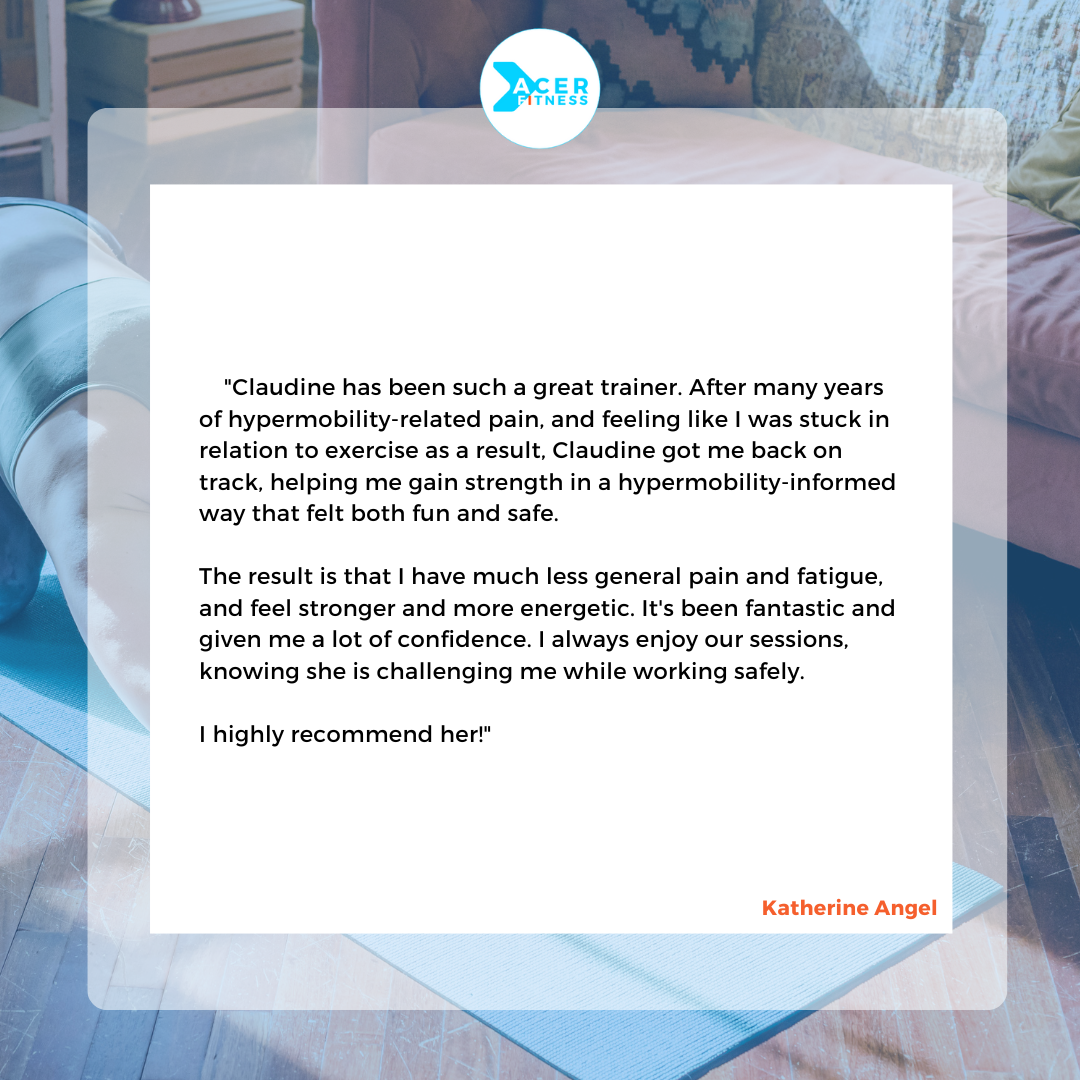
THE HYPERMOBILITY SPECIALISTS
THE HYPERMOBILITY SPECIALISTS
BUILDING RESILIENCE THROUGH STRENGTH
THE HYPERMOBILITY SPECIALISTS
BUILDING RESILIENCE THROUGH STRENGTH
Have you been diagnosed with Hypermobile Ehlers-Danlos Syndrome (hEDS) or Hypermobility Spectrum Disorder (HSD)? Or maybe your GP or physiotherapist has recommended a strength training programme for hypermobility. If so, you've come to THE right place!
Our experienced team of personal trainers at Acer Fitness have been training people from all walks of life for over 15 years. We focus primarily on helping people on the hypermobility spectrum. Our specialist, expert knowledge and understanding can be life changing; empowering our clients to take control over their condition using tailored exercise programmes to build strength and resilience. No two people on the spectrum are likely to present with the exact same array of symptoms, and so a structured, unique approach from trainers who fully understand the challenges of a hypermobile body is vital and can bring huge benefits.
WHAT IS HYPERMOBILITY?
A person with hypermobility has joints with a greater range of movement than would usually be expected. For some this is completely asymptomatic. For others, it causes pain and discomfort in the joints with a range of other symptoms. Additional problems alongside an extended range of movement around several joints is referred to as hEDS (Hypermobile Ehlers-Danlos Syndrome) or Hypermobility Spectrum Disorder (HSD)
WHAT IS HYPERMOBILITY?
A person with hypermobility has joints with a greater range of movement than would usually be expected. For some this is completely asymptomatic. For others, it causes pain and discomfort in the joints with a range of other symptoms. Additional problems alongside an extended range of movement around a number of joints is referred to as hEDS (Hypermobile Ehlers-Danlos Syndrome) or Hypermobility Spectrum Disorder (HSD).

The major complications associated with hEDS are musculoskeletal.
Recurring joint dislocation, often alongside degenerative joint diseases are responsible for a baseline chronic pain associated with hEDS which has a negative effect on both physical and psychological wellbeing.
hEDS is a disorder of the connective tissue. Collagen is present in ligaments, tendons, skin and bone. Abnormal production, structure, or processing of the collagen results in a reduction in strength of the tissue and makes the structures more elastic and less stable. This allows excessive movements of the body's joints and a lack of control around the capsules.
Because the muscles need to work much harder to stabilise loose joints, compensating for the weakened connective tissue, chronic pain and fatigue are prevalent and often debilitating. The paradox is that loose joints often result in stiffness, which certainly becomes more noticeable over time.
Exercise has been proven to prevent many chronic diseases from heart disease to diabetes. Exercise is important for all of us but has additional benefits for those with hEDS. While the condition cannot be prevented, a specialised strength and conditioning programme is vital for managing and relieving the pain and discomfort associated with hypermobile joints.

CORRECTIVE EXERCISE
Core stability and postural correction go a long way to managing hEDS, but this is only the start. Corrective exercise prescription can alter dysfunctional movement patterns commonly seen with Hypermobility spectrum disorders such as:

- Poor scapula control, winging and instability. Strengthening the rotator cuff muscles, serratus anterior and rhomboids and lengthening through the anterior chain can provide greater stability reducing the risk of bursitis, impingement and overuse injuries.
- Poor control of the hip, pelvic and lumbar regions. Exercises can address lower cross syndrome by mobilising tight muscles and strengthening their weak antagonists.
- The knee is a slave to the hip and the ankle (including problems associated with both flat feet and over pronation) and so problems originating above or below in the kinetic chain can present at the knee. Hyperextension also causes fatigue and instability.
- Reduced movement in the thoracic spine.
- Weak neck stabilisers and overworked upper trapezius that cause pain and headaches.
- Poor balance, co-ordination and proprioception can also be addressed through exercise reducing the risk of falls and sprains and of course improving performance in sport.
Strength without flexibility causes rigidity, and flexibility without strength causes instability.
WHY
US?
At Acer Fitness we are experts in our field. We have been specialising in connective tissue disorders for many years and have first-hand experience of living with hEDS, so we fully understand our clients' needs. Having previously worked in gyms, sports injury clinics and in partnership with a number of physiotherapy and osteopathy practices, we have extensive knowledge of the effects this condition can have on everyday life, and the huge benefits that a tailored programme has on pain management and injury prevention and rehab.
HOW WE
WORK
Technology has allowed us to open up our services to all who want to benefit, no matter your location. The majority of our clients train remotely and have achieved identical results as they would have were their trainer in the room with them. You receive the same level of care and expert guidance. Of course, if we have a trainer local to you they can visit you in person if you prefer, but this is not always feasible. We believe that finding a specialist who fully understands the complications of hEDS is vital and geography should not be a barrier to receiving the right help.
WE PARTNER WITH YOUR HEALTHCARE
Our ideal scenario at Acer Fitness is to have a close working relationship with your other healthcare professionals, including your GP or consultant, physiotherapists and osteopaths etc. This allows us to provide a 'joined up' approach to give you the best possible outcomes. It enables us to deliver a 360° continuous progression of treatment, rehabilitation, corrective and functional exercise.

PHYSICAL AND PSYCHOLOGICAL ISSUES ASSOCIATED WITH JOINT HYPERMOBILITY
People with hEDS may have:
• joint hypermobility
• joint pain and clicking joints
• loose, unstable joints that sublux or dislocate easily
• skin that is prone to bruising
• digestive problems such as IBS
• postural hypotension (dizziness upon standing)
• extreme or chronic fatigue
There can also be many autonomic nervous system issues that may present themselves. This system is responsible for regulating body functions and the fight-or-flight response.
Take a look at the diagnostic criteria for hEDS and Joint hypermobility spectrum disorders for more details.
MONTHLY SUBSCRIPTION
Our services are provided as a monthly subscription. This gives you both consistency and accountability to help you achieve your results. You can choose to have 1, 2 or 3 training sessions per week, or select our hybrid option which includes 1 live session per month alongside home programmes. We also have small group live video sessions for a maximum of 4 clients, where we group you with people of the same fitness level with similar hypermobility challenges. There are packages to suit everyone.
RESOURCES
We want this website to be a really helpful portal, full of resources to support people with hypermobility spectrum disorders, or indeed, people who just want to take control of their lives through fitness and exercise. Check out our articles for lots more information about hEDS and hypermobility.

CONTACT US

ACER FITNESS LTD
71-75 Shelton Street, Covent Garden,
London, WC2H 9JQ







